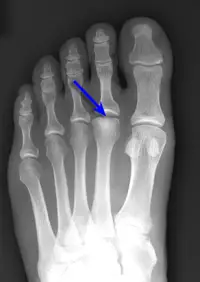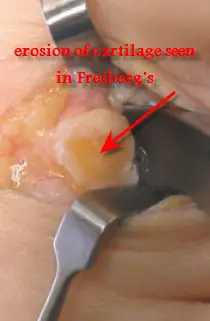Freiberg's disease
AUTHOR: Marc Mitnick DPM home --> Freiberg's diseaseWHAT IS FREIBERG'S DISEASE
Freiberg's disease is also commonly known as Freiberg's infraction which means incomplete fracture or Freiberg's infarction which means necrosis or bone death due to obstruction of circulation.
In any event the condition is a result of avascular necrosis meaning the blood supply to the affected bone has been cut off causing the bone to undergo changes usually resulting in pain.
The disease can vary in severity and usually gets worse as time goes on. It usually begins in the second decade of life however may not manifest itself as pain until the patient reaches their early twenties. It is far more common in females then males.
As previously mentioned it is thought to be due to disruption of circulation to the head of the metatarsal bone, usually, but not always the second metatarsal bone. This disruption is thought to occur primarily from repetitive stress (such as running or wearing high heel shoes) and not necessarily one incidence of trauma. The trauma is to the growth plate of the bone (from which the bone grows in length over time), which is located at the distal (front) part of the bone nearer the toes.
The repeated stress to the growth plate of the bone causes micro fractures in the growth plate which eventually lead to a disruption of the blood supply to that area of the bone. It occurs while this growth plate is open (growth plates eventually close and there is no longer any further bone growth) which is during puberty. During this time period there is rarely pain.
SYMPTOMS OF FREIBERG'S DISEASE
While the growth plate is open, there is rarely pain, but the pain occurs later on, generally in females in their twenties and early thirties in response perhaps to wearing high heels or participating in athletics.
 Freiberg's disease x-ray |
Typically the patient complains of localized pain in the ball of the foot near the bone that is affected. The affected area may also be slightly red and swollen. There may also be limitation of motion of the affected toe. The pain is usually exacerbated by excessive activity and can worsen overall with time. In women, high heels may aggravate the pain.
An xray reveals the classic flattening of metatarsal head. There can also be fracture and fragmenting of the bone resulting in loose bodies of bone in the area causing further pain. All of this leads to degeneration of the joint between the metatarsal bone and toe.
HOW DO YOU TREAT FREIBERG'S DISEASE
The treatment of Freiberg's disease is dependent on the amount of bone destruction and the amount of pain the patient is experiencing.
conservative treatment
- In the younger patient who is in the early stages of bone destruction, the acute stage, it may be appropriate to try a non-weightbearing cast for a minimum of four weeks in an effort to prevent further bone and joint destruction.
- Some patients will do fine with a walking cast or even a stiff soled shoe. The problem here becomes one of patient compliance as it is very easy to "cheat" and not wear the shoe or cast all the time.
- Anti-inflammatory medication may be given in conjunction with the cast to reduce symptoms.
- After the patient is clinically healed they should limit themselves to very conservative, stiff shanked shoes to limit the bending at the ball of the foot.
- An orthotic may also provide protection as well. Generally the orthotic should have a metatarsal bar built in to take pressure off the head of the bone.
- High heels are definitely out of the question, as is athletic endeavors.
- Patient compliance is a must in these situations because if the disease cannot be “quieted” down there will be further damage to the metatarsal bone resulting in chronic pain.
Freiberg's disease surgery
In those situations where conservative measures have failed, surgery becomes a viable option. An MRI of the bone and joint should be performed prior to any surgical procedure in order to get a clear picture of the diseased joint, to see if there are any loose bone fragments in the joint and to check the overall bone stock or quality of the metatarsal bone.

|
Surgical procedures:
- Cleaning out the diseased joint of bone spicules (bone spurs) and to remove actual loose bone bodies floating around the joint.
- Drilling holes into the metatarsal head in an effort to increase circulation to the head of the metatarsal.
- Partial metatarsal head resection where a portion of the metatarsal head is removed. Care must be taken because if too much bone is removed, it will transfer body weight to the adjacent metatarsal head which may then cause pain in that metatarsal.
- Dorsiflectory wedge osteotomy, where the head of the metatarsal bone is actually elevated up slightly by cutting into the top portion of the bone. This takes pressure off the bottom part of the metatarsal head and can reduce symptoms.
- Even though lesser metatarsal implants exist, at this writing, there is not a general consensus that they are effective in treating Freiberg's disease.
REFERENCES
Want more information? CLICK HERE


Recent Articles
-
Vitamin D impact on health
Feb 06, 23 07:17 PM
Researchers are suggesting that the effectiveness of Vitamin D in fighting and preventing disease is predicated on a persons body mass index (BMI). The thinner the person the greater the positive impa… -
Foods to speed up healing
Feb 01, 23 02:41 PM
One of the best ways to help yourself heal faster after surgery is to eat well. Getting the proper nutrition will provide your body with the essentials it needs to promote healing. Here is a suggestio… -
Cancer and Type 2 Diabetes
Jan 25, 23 04:52 PM
An article revealing that older type 2 diabetics have a higher incidence of cancer then non-diabetics. It is suggested that cancer may surpass CVD as the number one cause of death in older diabetics. -
Does glucosamine or MSM reduce arthritis pain?
Jan 22, 23 01:41 PM
A good review of the possible benefits to taking glucosamine, chondroitin or MSM for arthritis. Always beware of the possible side effects of over the counter supplements. -
shin splints
Jan 18, 23 05:12 PM
A great review on the various causes of shin splints, along with treatment options. -
Whats new in skin cancer?
Jan 15, 23 08:32 PM
A presentation of newer skin protection combinations in an effort to better protect the skin from the hazards of sun exposure. -
Causes and risk factors of warts
Jan 14, 23 05:02 PM
A good review of the causes of warts and protective measures you can take to prevent developing them. -
Do chronic wounds need to be dressed daily?
Jan 11, 23 02:18 PM
Because of supply chain shortages as well as staffing shortages particularly during the pandemic, many institutions extended the time between dressing changes for chronic wounds. Is this really the be… -
Food choices that raise your risk of type 2 diabetes
Jan 08, 23 10:07 AM
A good review of how blood sugars can become elevated and the harm that can do. Certain food groups have a tendency to raise your blood sugars and should be avoided. -
Outcome stats from Scarf bunionectomy
Jan 03, 23 03:04 PM
The Journal of Foot and Ankle Surgery recently reported a meta analysis of outcomes in 1583 Scarf bunionectomies that met their inclusion criteria. Adverse events did not seem to be any better or wors…